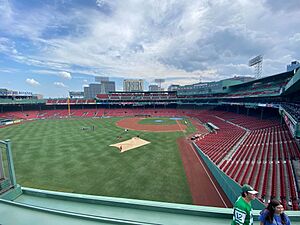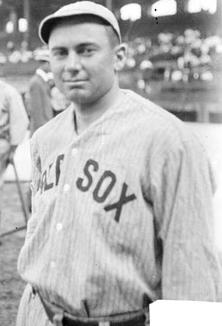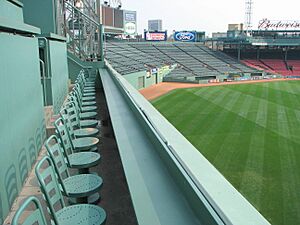Green Monster facts for kids
The Green Monster is a famous nickname for the tall wall in left field at Fenway Park. This park is the home of the Boston Red Sox, a team in Major League Baseball. The wall is about 37-foot-2-inch-high (11.33 m) and stands 310 feet (94 m) away from home plate. It's a popular target for right-handed batters who try to hit the ball over it.
Contents
About the Green Monster
The Green Monster was built in 1912 when Fenway Park was first made. It's on the north side of the park, facing Lansdowne Street. The wall was originally made of wood. Later, in 1934, it was covered with tin and concrete. In 1976, it got a new covering of hard plastic.
A manual scoreboard is built into the wall. This scoreboard has been there since at least 1914. Even though it's called the "Green Monster," the wall wasn't always green! It was painted green in 1947. Before that, it was covered with many advertisements. For most of its history, people just called it "The Wall." The name "Green Monster" is actually quite new.
The Green Monster is the tallest wall in any current Major League Baseball park. It's the second tallest in all professional baseball fields, including smaller leagues. In 2007, another wall called "The Arch Nemesis" in York, Pennsylvania, became slightly taller.
Many old baseball parks had tall fences. These fences helped hide the field from people outside. They also stopped too many "cheap" home runs from being hit. Fenway's wall does both of these things. Fenway is the last major-league ballpark with such an extra-high wall.
The Red Sox mascot, Wally the Green Monster, is named after this famous wall.
How the Wall Affects the Game
The Green Monster is famous for stopping many hard-hit balls from becoming home runs. Instead, these balls often hit the wall and bounce back into the field. This usually results in a double, which is why these are often called "wallball doubles."
A Red Sox player named Earl Webb set a record for doubles in 1931. He hit 67 doubles that season. This record has rarely been broken since then.
Some left fielders who play for the Red Sox become very good at fielding balls that bounce off the wall. They learn how the ball will bounce. This helps them throw runners out or keep batters from getting extra bases. The wall is quite close to home plate, about 304–310 feet (93–94 m) along the foul line. This short distance means many deep fly balls hit the wall instead of being caught.
While the wall stops many home runs, it can also turn some high, shallow fly balls into home runs. This happens if the ball just barely clears the wall. For example, Bucky Dent hit a famous home run over the wall in a big game in 1978.
Special Features of the Wall
Duffy's Cliff

From 1912 to 1933, there was a 10-foot-high (3.0 m) mound in front of the Green Monster. This mound was like a small hill. It was called "Duffy's Cliff" because of Duffy Lewis, a famous Red Sox left fielder. He was very good at playing balls on this uphill area.
Sometimes, when there were too many fans, they would sit on this mound. In 1934, the Red Sox owner, Tom Yawkey, had the mound flattened. Since then, "Duffy's Cliff" has only been a part of Fenway Park's history.
The Scoreboard
The manual scoreboard at the bottom of the Green Monster was put there in 1934. It's still updated by hand during games. Workers behind the wall change the scores for the American League. For the National League scores, they have to change them from the front of the wall between innings.
There's also a board that shows the current standings for the American League East division. The scoreboard has 127 slots. A team of three scorekeepers uses two-pound (0.9 kg) plates to show the scores. Yellow numbers are used for scores during an inning, and white numbers are for final inning scores. The numbers for the current pitchers are heavier, weighing three pounds (1.4 kg).
Secret Morse Code
If you look closely at the white lines in the American League section of the scoreboard, you can see Morse code. This code spells out the initials of former owners, Thomas A. Yawkey (TAY) and Jean R. Yawkey (JRY).
Green Monster Seats
In 1936, the Red Sox put a 23-foot (7.0 m) net above the Monster. This net was there to protect buildings on Lansdowne Street from home run balls. The net stayed until 2002.
Then, the team's new owners built a new seating area on top of the wall. These "Monster seats" can hold 274 fans. They became very popular! In 2005, a smaller seating section called the "Nation's Nest" was added nearby.
The Ladder
There's a ladder attached to the Green Monster. It goes from near the scoreboard to the top of the wall, about 13 feet (4.0 m) above the ground. In the past, grounds crew members used this ladder to get home run balls out of the net.
Even though the net is gone, the ladder is still there as a historic piece. What's interesting is that the ladder is in fair territory, meaning it's part of the playing field. Sometimes, a batted ball hits the ladder during a game. This has even led to an inside-the-park home run a couple of times!
For example, in 1963, a Red Sox player named Dick Stuart hit a high fly ball. It hit the ladder, then bounced off a Cleveland outfielder's head, allowing Stuart to score.
Advertisements
After the wall was painted green in 1947, no ads appeared on it until 1999. That year, the All-Star Game was held at Fenway. Since then, different ads have appeared above the scoreboard.
Large Coca-Cola bottles were on the left light tower from 1997. These were taken down before the 2008 season. Now, an LED sign is above the new left-field seats.
Similar Walls in Baseball
Major League Baseball Parks
- Oracle Park, home of the San Francisco Giants, has a 24-foot-high (7.3 m) right field wall. This height honors Willie Mays, whose uniform number was 24.
- PNC Park, home of the Pittsburgh Pirates, has a 21-foot-high (6.4 m) right field wall. This pays tribute to Roberto Clemente, who wore number 21.
- Progressive Field, home of the Cleveland Guardians, has a 19-foot-high (5.8 m) left field wall, sometimes called the "little green monster."
Other Baseball Parks
- JetBlue Park in Fort Myers, Florida, is where the Red Sox have spring training. It has a copy of the Green Monster. This replica even has a manual scoreboard just like Fenway's.




